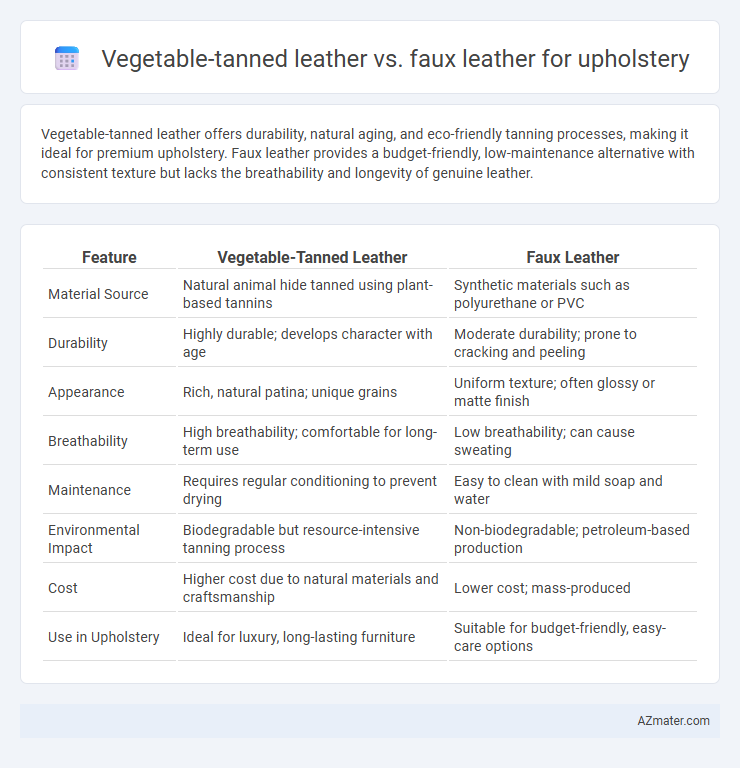Vegetable-tanned leather offers durability, natural aging, and eco-friendly tanning processes, making it ideal for premium upholstery. Faux leather provides a budget-friendly, low-maintenance alternative with consistent texture but lacks the breathability and longevity of genuine leather.
Table of Comparison
| Feature | Vegetable-Tanned Leather | Faux Leather |
|---|---|---|
| Material Source | Natural animal hide tanned using plant-based tannins | Synthetic materials such as polyurethane or PVC |
| Durability | Highly durable; develops character with age | Moderate durability; prone to cracking and peeling |
| Appearance | Rich, natural patina; unique grains | Uniform texture; often glossy or matte finish |
| Breathability | High breathability; comfortable for long-term use | Low breathability; can cause sweating |
| Maintenance | Requires regular conditioning to prevent drying | Easy to clean with mild soap and water |
| Environmental Impact | Biodegradable but resource-intensive tanning process | Non-biodegradable; petroleum-based production |
| Cost | Higher cost due to natural materials and craftsmanship | Lower cost; mass-produced |
| Use in Upholstery | Ideal for luxury, long-lasting furniture | Suitable for budget-friendly, easy-care options |
Introduction to Vegetable-Tanned Leather and Faux Leather
Vegetable-tanned leather is crafted using natural tannins from plant sources, providing durability, breathability, and a unique patina that develops over time, making it ideal for high-quality upholstery. Faux leather, made from synthetic materials like polyurethane or polyvinyl chloride, offers a cost-effective, water-resistant, and low-maintenance alternative that mimics the appearance of genuine leather. Both materials serve upholstery purposes, but their distinct textures, environmental impacts, and longevity differ significantly.
Material Origins and Production Processes
Vegetable-tanned leather originates from animal hides treated with natural tannins derived from tree bark, leaves, and fruits, undergoing a slow, eco-friendly process that enhances durability and develops a unique patina over time. Faux leather is made from synthetic materials such as polyurethane or polyvinyl chloride (PVC), produced through chemical processes that mimic the appearance of real leather but often result in lower breathability and environmental concerns due to plastic-based components. Understanding the distinct material origins and production methods is crucial for selecting upholstery that balances aesthetics, sustainability, and longevity.
Environmental Impact Comparison
Vegetable-tanned leather is biodegradable and produced using natural tannins from tree bark, leading to less environmental pollution compared to chemical-intensive chrome tanning in faux leather manufacturing. Faux leather, often made from polyvinyl chloride (PVC) or polyurethane (PU), generates significant plastic waste and microplastics, contributing to landfill overload and ocean pollution. Choosing vegetable-tanned leather reduces reliance on fossil fuels and minimizes toxic chemical runoff, making it a more eco-friendly option for upholstery materials.
Durability and Longevity of Each Material
Vegetable-tanned leather offers exceptional durability and develops a rich patina over time, making it highly resistant to wear and ideal for long-lasting upholstery. Faux leather, typically made from polyurethane or PVC, provides moderate durability but tends to crack and peel sooner under heavy use or exposure to heat and sunlight. The natural fibers and strong tanning process in vegetable-tanned leather significantly extend its lifespan compared to synthetic alternatives, which require more frequent replacement.
Comfort and Feel: User Experience
Vegetable-tanned leather offers a natural, breathable texture that becomes softer and more supple over time, enhancing long-term comfort for upholstery users. Faux leather provides a consistent smooth surface but lacks the same breathability, which can lead to increased heat and moisture buildup during extended use. Users often prefer vegetable-tanned leather for its warm, organic feel and ability to age gracefully, making it more comfortable in diverse climates.
Aesthetic Appeal and Customization Options
Vegetable-tanned leather showcases a rich, natural patina that deepens with age, offering unique textures and colors that enhance the aesthetic appeal of upholstery with an organic, luxurious look. Faux leather provides a wide range of colors, patterns, and finishes, allowing for more versatile customization to suit modern design preferences and budget constraints. Both materials offer distinct customization options, but vegetable-tanned leather excels in creating elegant, timeless pieces, while faux leather supports innovative and diverse design choices.
Maintenance and Care Requirements
Vegetable-tanned leather requires regular conditioning with natural oils to maintain its durability and prevent cracking, while avoiding prolonged exposure to direct sunlight and moisture. Faux leather demands less intensive maintenance, typically needing only occasional cleaning with mild soap and water to prevent surface cracking and peeling. Both materials benefit from prompt spill cleanup and gentle handling to extend their upholstery lifespan.
Cost Considerations and Value for Money
Vegetable-tanned leather typically commands higher upfront costs due to its natural tanning process and durability, making it a premium choice for upholstery with excellent aging characteristics. Faux leather offers a more budget-friendly alternative while providing water resistance and ease of maintenance, though it lacks the longevity and patina development of genuine vegetable-tanned leather. Evaluating value for money involves considering durability, maintenance, and the intended lifespan of the furniture, where vegetable-tanned leather often proves more cost-effective over time despite its initial price.
Ethical Factors and Sustainability
Vegetable-tanned leather, derived from natural tanning processes using plant-based materials, offers a more sustainable and biodegradable option compared to synthetic faux leather, which is typically made from non-renewable plastics like PVC or polyurethane. Ethical considerations favor vegetable-tanned leather as it involves fewer harmful chemicals and supports traditional craftsmanship, whereas faux leather production often entails significant environmental pollution and poses challenges in waste management. Choosing vegetable-tanned leather promotes ecological balance through biodegradability and reduced chemical impact, while faux leather's synthetic nature emphasizes durability and animal-free ethics but at the cost of environmental sustainability.
Choosing the Best Upholstery: Vegetable-Tanned vs Faux Leather
Vegetable-tanned leather offers durability, natural breathability, and develops a unique patina over time, making it ideal for high-quality upholstery that ages gracefully. Faux leather provides a budget-friendly, low-maintenance alternative that resists stains and water, suitable for environments requiring easy cleaning and vegan material options. Evaluating factors such as longevity, environmental impact, and aesthetic preferences helps determine the best upholstery choice between vegetable-tanned and faux leather.

Infographic: Vegetable-tanned leather vs Faux leather for Upholstery
 azmater.com
azmater.com